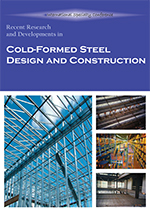Session Dates
24 Aug 2012 - 25 Aug 2012
Abstract
This paper points out that the shear lag factors embedded in the design equations specified in the North American, European and Australasian cold-formed steel structures codes for determining the net section tension capacity of bolted connections in flat steel sheets either yield “anomalous” results or become irrelevant when they exceed unity. The anomaly is demonstrated through laboratory tests and is explained using simple calculus. A proper mathematical expression for the in-plane shear lag factor, which does not suffer from the anomaly of the code equations and never implies shear lag factors greater than unity for any configuration, is presented and found to yield improved results compared to the current code equations. A resistance factor of 0.8 for the proposed equation is determined with respect to the LRFD approach given in the North American specification for the design of cold-formed steel structures.
Department(s)
Civil, Architectural and Environmental Engineering
Research Center/Lab(s)
Wei-Wen Yu Center for Cold-Formed Steel Structures
Meeting Name
21st International Specialty Conference on Cold-Formed Steel Structures
Publisher
Missouri University of Science and Technology
Document Version
Final Version
Rights
© 2012 Missouri University of Science and Technology, All rights reserved.
Document Type
Article - Conference proceedings
File Type
text
Language
English
Recommended Citation
Teh, Lip H. and Gilbert, Benoit P., "In-plane Shear Lag of Bolted Connections" (2012). CCFSS Proceedings of International Specialty Conference on Cold-Formed Steel Structures (1971 - 2018). 2.
https://scholarsmine.mst.edu/isccss/21iccfss/21iccfss-session9/2
In-plane Shear Lag of Bolted Connections
This paper points out that the shear lag factors embedded in the design equations specified in the North American, European and Australasian cold-formed steel structures codes for determining the net section tension capacity of bolted connections in flat steel sheets either yield “anomalous” results or become irrelevant when they exceed unity. The anomaly is demonstrated through laboratory tests and is explained using simple calculus. A proper mathematical expression for the in-plane shear lag factor, which does not suffer from the anomaly of the code equations and never implies shear lag factors greater than unity for any configuration, is presented and found to yield improved results compared to the current code equations. A resistance factor of 0.8 for the proposed equation is determined with respect to the LRFD approach given in the North American specification for the design of cold-formed steel structures.



